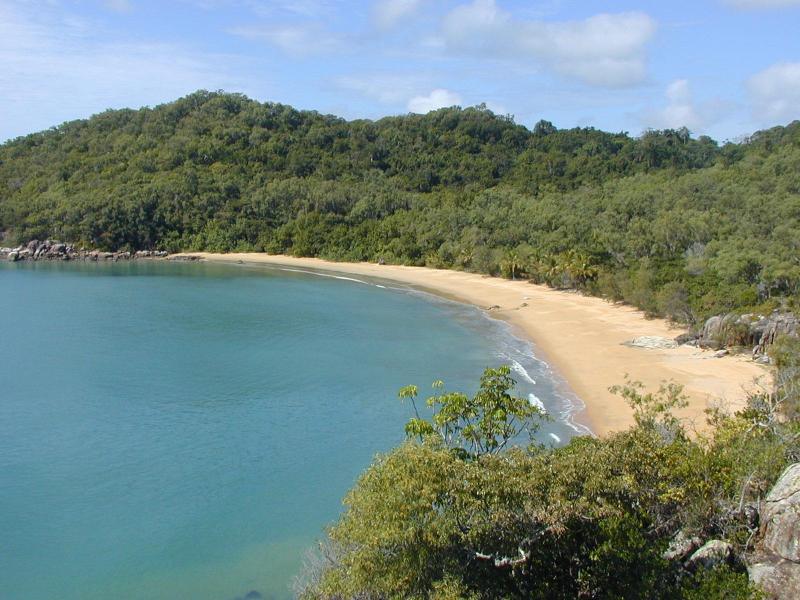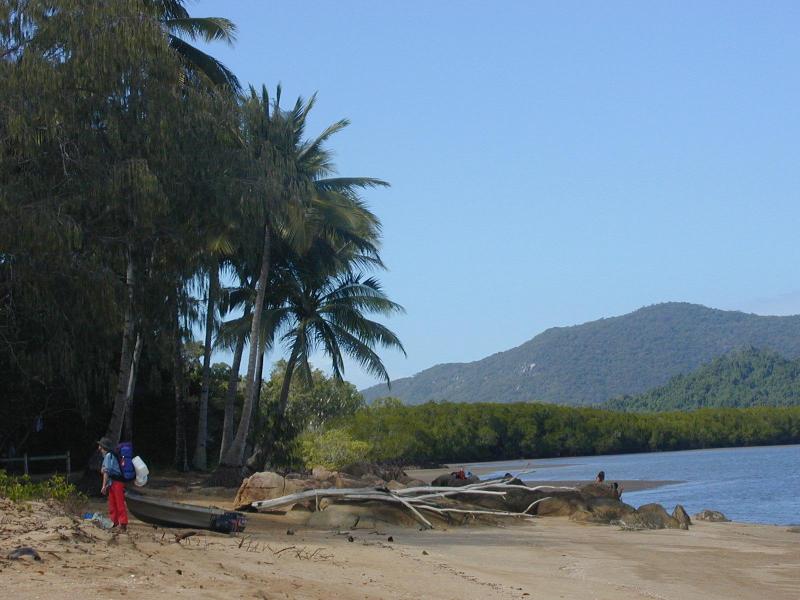Hinchinbrook Island Guide
Hinchinbrook Island, Australia’s largest, most pristine island national park, is a landscape spectacle of sandy beaches, precipitous headlands, waterfalls, rugged mountains, mangrove creeks, sheltered bays and dense rainforests.
Hinchinbrook Island is in northern Queensland, Australia, just north of the town of Ingham, approximately 150 km south of the city of Cairns. Separated from the mainland by the narrow Hinchinbrook Channel, the entire island is zoned as a National Park. Access to the park is strictly limited and, when much of Queensland teems with tourists, here you can truly experience untouched nature.
The only regular means of access to the island is Hinchinbrook Island Ferries from Cardwell on mainland, 2 hours south of Cairns. Boats leave at 9 AM and return at 5 PM, daily in the high season (May-Oct), three times weekly in the low season (Nov-Apr). A day cruise is $90, one-way transfers to the northern start of the Thorsborne Trail are $66. Pickups from the southern end point can also be arranged.

Orchid Bay, Hinchinbrook Island. Photo by Jpatokal
The beaches of Hinchinbrook Island are, in a word, spectacular. All located on the eastern side, starting from north the most commonly visited are:
Orchid Beach. Next to the HI Resort and effectively its own private beach.
North Shepherd Beach. A half-hour walk from the Resort, a gloriously empty 2-kilometre stretch of beach. Spot the countless tiny ghost crabs skittering about on the sand.
South Shepherd Beach. Two hours hike south of North Shepherd. Very remote, you are almost certain to have this all to yourself.
Ramsay Beach. This beach is many kilometres long, fringed by a high dune that extends through scrubland to an esturary, which is great for fishing. The only infrastructure on the island is a resort at the northeastern corner of Hinchinbrook Island at Cape Richards. It is possible to reach Ramsay Bay by guided wilderness tour, or by private yacht.
Cape Richards, at the northernmost tip of the island, has a lookout point for gazing out Goold Island, the open sea and down at Orchid Beach. A fairly easy trail leads up from the HI Resort.
Missionary Bay, on the northwestern side of the island, contains a large mangrove swamp famous for its dugongs (sea cows) and infamous for its crocodiles, although you’ll have to be quite lucky to spot either one.
At one point in the mangroves (visited by the ferry), a 60-metre boardwalk has been constructed, which leads to a 200-metre path to Ramsay Beach.
Mangroves can also be found in Turtle Bay, a short hike away from the HI Resort near Cape Richards.
The Thorsborne Trail is a 32-kilometre trail that winds the length of Hinchinbrook Island from Ramsay Bay in the north to George Point in the south. Most hikers complete the course in 4 days (3 nights), although this depends on experience and weather conditions. There are no facilities on route (although drinking water can usually be taken from mountain streams) and hikers must be completely self-contained, including food, fuel stoves (open fire not allowed) and camping equipment.
A permit is required and must be reserved well in advance in high season, as a maximum of 40 people are allowed on the trail simultaneously. Contact the Queensland Department of Environment Rainforest and Reef Centre in Cardwell. You must also arrange to be picked up from George Point in advance, as there is no scheduled service.
Note that the permit covers only the Thorsborne Trail. Special permits are required for other destinations, particularly Mt. Bowen (1142m).
In addition to trekking, fishing is popular at a number of sites in and around the park. Snorkelling and even scuba diving are also possible, but visibility tends to be comparatively poor.

Macushla Beach, Hinchinbrook Island. Photo by Jpatokal
There are no shops on the island. Some basic necessities are available for sale at Hinchinbrook Island Wilderness Lodge. The Lodge restaurant is open to non-residents as well. Given the location and lack of competition, the food is surprisingly good, with large portions $25 and up.
Accommodation on Hinchinbrook is very limited, and many visitors opt to day-trip from Cardwell instead. Most overnight visitors’ means of accommodation is camping. In addition to the basic campsites along the Thorsborne Trail, there are three popular campsites outside the trail:
Macushla, south of the resort and within easy striking distance of the Shepherd Beaches. The best facilities on the island, including toilets, gas barbecue, picnic tables and water (not drinkable).
Goold Island. Small island to the north of Hinchinbook. Fully equipped campsite on a long, sheltered beach. There is no water supply, so bring your own.
Garden Island. Very small island to the north of Hinchinbrook. Outside the National Park, so no permits required.
Note that both Macushla and Goold Island require permits, obtainable in Cardwell or online.
Crocodiles are sometimes found in the muddier waters of the western side of the island. The eastern beaches are generally considered safe, although crocodiles are known to frequent the estuary at Zoe Bay. If camping overnight, stay at least 50 metres away from water and don’t leave food nearby or out in the open.
Goannas, large lizards up to two meters long, are very common on the island. They are harmless and will usually skitter away when approached.
The high season of the island is during the Australian winter (May-October), when the weather is cool and pleasant. Services in the low season are limited and both ferries and the island’s sole resort stop operating in the February-March cyclone season.






This valuable blog post, “? Hinchinbrook Island guide ? Tropical Destinations” displays the fact that you
truly understand precisely what u r speaking about!
I really totally agree. Thanks -Glen